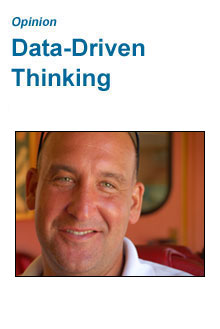 “Data-Driven Thinking” is a column written by members of the media community and containing fresh ideas on the digital revolution in media.
“Data-Driven Thinking” is a column written by members of the media community and containing fresh ideas on the digital revolution in media.
Today’s column is written by Andy Monfried, CEO at Lotame.
There’s been a lot of chatter in the marketplace of late on the evolving nature of DSPs, networks, SSPs, agencies, and data providers. Like it or not, direct response advertisers have moved the market—they started with ad networks over 10 years ago, took early control of search advertising, were among the first buyers of mass exchange inventory, and now gobble up cookies in DSPs.
Good for them.
If you look at the list of Fortune’s top 1,000 companies, Inc’s 500, or Forbes biggest companies, few of them sell or will ever sell products online at scale. Even for those that do, to wit, I suddenly didn’t wake up this morning and intend to buy an iTouch for my twins; there was awareness, which Apple has done across all media, consideration, deliberation, favorability, and finally intent. The current rush to the bottom of the purchase funnel devalues or otherwise ignores the top.
What constitutes a disproportionate share of buying on Demand Side Platforms today?
- Retargeting – A pixel, a pixel, my kingdom for a pixel. What’s happening? The “shell game” takes place around bidding up on inventory where most of the US Internet population spends part of their day—on portals and social networks. With “last click / last view” still ruling conversion attribution models, it’s easy to manipulate conversion credits because the odds are very high that someone visits a major portal or social network just before taking the conversion step. Further, it’s possible for a seller with sufficient scale to cookie every unique on behalf of its largest CPA advertiser, and use those cookies as proof of last impression, even if that impression was not visible or tied to a campaign.
- “In market” purchase intent – matching cookies (data) with media to buy an audience of intenders. Not all intent data is created equal however, and there’s a finite shelf life for many attributes. Today, there is little transparency into the recency or frequency of intent data, and we expect this opaque market to open up as marketers increasingly demand transparency on every piece of the media equation – site, placement, ad, data source, data ‘freshness,’ and other cookie-level attributes for that audience. The old adage of “don’t tell me how it works, just make it happen” (which works for DR advertisers) will give way to “prove to me where, when, how, and why you just made a decision with my money.”
- Site-clustered cookie pools – Consumer A converts on advertiser page B (pixel 1 fires) and then visits a deep page on site C (pixel 2 fires). All other people who visit site C page then become candidates for “look-a-like” advertising. This is site and page clustering, and what we did at Advertising.com almost 10 years ago. To be sure, it can be very effective and drive results, but there are many other reasons to use a DSP.
Is a DSP’s only purpose bottom-of-the-purchase-funnel targeting? I think not, dear sirs and madams. How do we create value for consumer packaged goods companies? How does it scale for entertainment? Are we just schilling eyeballs? True value comes from understanding online human behavior from all levels in the funnel, and ascribing attribution value for each touchpoint—derived from media, data, time, transparency, and actions—and accomplishes three tasks:
1) Understanding what moves consumers from top to bottom
2) Learning what works, what didn’t, and have a repeatable set of inputs that lead to greater outputs, no matter what the performance metric, but unequivocally beyond the click
3) Valuing publisher inventory and data correctly instead of a race to the bottom of the direct response barrel
The holy grail is not just cookie targeting, but to see the linkage between the top of the funnel and the bottom. We have a saying in the office that to have intent, you need to create intent, and this is TRUE.
DSPs of the future will enable the attribution models of the future – for every touchpoint.
Are we there yet? Nope. The infrastructure is not set-up at the publisher or advertiser level, agencies have a talent shortage, and there is no single entity (yet) that captures—in a way that is respectful of consumer privacy—all digital signals in the noise of the online human experience.
Despite increased share of time online, marketers disproportionately underinvest in digital marketing relative to other marketing channels. The fault lies not just in them, but in ourselves for the acronym soup we use to create and destroy our own value.
One thing we can all be sure of is this: our jobs are to make buying (with other people’s money!) easier, transparent, and scalable. Is all the chatter about DSPs making it easy to move money to digital media? Or it is intimidating and confusing our audience?
You decide.
Follow Lotame (@lotame) and AdExchanger.com (@adexchanger) on Twitter.












